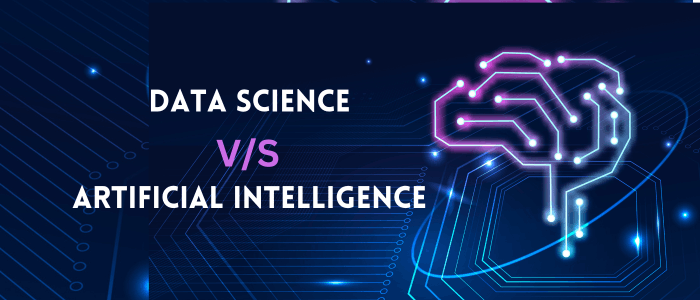Today, we’re boarding the ship on a delightful journey into the whimsical worlds of Data Science and AI. These two buzzwords have been tossed around so much lately that they’ve become as mysterious as that secret sauce recipe at your favorite burger joint. But fret not, dear reader, for we’re about to demystify this duo, all while keeping the mood light and the explanations crystal clear.
Defining Data Science and AI
Imagine you’re baking a cake. Data Science is like the baker who carefully measures ingredients mixes them, and bakes the cake to perfection. It’s all about extracting knowledge and insights from data using statistics and machine learning. So, when you hear about data analysts and statisticians crunching numbers, they’re probably part of this club.
On the other hand, Artificial Intelligence (AI) is your cake that comes to life! It’s the branch of computer science where machines mimic human intelligence. AI systems can learn, reason, and solve problems. Think of Siri or Alexa—they use AI to understand your voice commands. AI is the sparkly magic dust that gives machines the ability to think and make decisions.
Core Components of Data Science
Now, let’s dive deeper into Data Science’s treasure chest. Its core components are like the pillars holding up a grand mansion:

Data Collection: Imagine being a data collector is like being a professional hoarder of information. You gather data from various sources-from surveys to sensors, social media to spreadsheets.
Data Cleaning: If data collection is a treasure hunt, data cleaning is like polishing those precious gems. It involves sorting, removing duplicates, and fixing errors in the data.
Data Analysis: This is where the magic happens! You use statistical techniques and machine learning algorithms to uncover patterns, trends, and insights from the data. It’s like solving a detective puzzle.
Data Visualization: To make those insights digestible, Data Scientists create eye-catching charts, graphs, and dashboards. Think of them as the artists of the data world.
The Essence of Artificial Intelligence (Core Component)
Now, let’s shift our gaze to the magnificent realm of Artificial Intelligence, where machines flex their intellectual muscles:

Machine Learning: This is like teaching your pet robot to fetch the newspaper every morning. Machine learning algorithms enable AI systems to learn from data and improve their performance over time. It’s the heart of AI.
Natural Language Processing (NLP): Ever marveled at how your phone understands your text messages? That’s NLP at work. It’s the art of making computers understand and generate human language.
Computer Vision: Picture this: you show a computer a picture, and it tells you what’s in it. Computer vision is like the digital eye that lets machines “see” and interpret images and videos.
Robotics: Robots are like the rockstars of AI. They’re designed to perform tasks autonomously, from vacuuming your living room to assembling cars in a factory.
Comparison of the Skill Sets Required:
Now that we’ve uncovered the treasures in both Data Science and AI, let’s see what skills you need to be part of these guilds:
Data Scientist Skills:
Mathematics and Statistics: Data Scientists need to be best pals with numbers, mastering concepts like probability, calculus, and linear algebra.
Programming: They often use languages like Python and R to write code for data analysis and visualization.
Data Wrangling: The ability to clean, preprocess, and transform data is crucial.
Domain Knowledge: Knowing the industry you’re working in is like having a compass in this data-driven world.
AI Professional Skills:
Machine Learning: Deep knowledge of machine learning algorithms and frameworks is a must.
Programming: Proficiency in languages like Python, Java, or C++ is essential for developing AI models.
Specialized Skills: Depending on your AI niche, you might need expertise in NLP, computer vision, or robotics.
Ethics: With great AI power comes great responsibility. Understanding the ethical implications of AI is crucial.
Collaborative Dynamics:
Now, here’s the fun part! Data Science and AI professionals often team up like Batman and Robin to tackle complex problems. Data Scientists provide clean, well-organized data, while AI professionals use their AI magic to make predictions, automate tasks, and create intelligent systems.
Imagine a data scientist like Sherlock Holmes gathering clues, and an AI like Watson, turning those clues into brilliant deductions. Together, they solve the mysteries of the digital world.
Salary of Data Scientists and How to Become One:
Let’s not kid ourselves; we all love a good paycheck. Data Scientists are often well-compensated for their skills. In the United States, the median salary for a Data Scientist hovers around $96,000 to $140,000 per year, depending on location, experience, and industry. Becoming a Data Scientist is a thrilling adventure. Here’s a simplified roadmap:
- Get Educated: Start with a bachelor’s degree in a relevant field like mathematics, statistics, or computer science. A master’s degree or specialized courses can give you an edge.
- Learn Programming: Become best buddies with programming languages like Python or R.
- Gain Experience: Internships, personal projects, and entry-level positions help build your portfolio.
- Master the Art: Dive into machine learning, statistics, and data analysis techniques.
- Keep Learning: The data world evolves, so stay updated with new tools and techniques.
Exploring Further Distinctions:
Data Science’s Breadth: Data Science encompasses a wide spectrum of activities, including descriptive analytics (what happened), diagnostic analytics (why it happened), predictive analytics (what might happen), and prescriptive analytics (what should we do about it). It’s like having a toolbox full of instruments, each serving a unique purpose.
AI’s Decision-Making Power: When you think of AI, think of decision-making at lightning speed. AI systems can make decisions in microseconds, something that would take humans hours or even days to process. From autonomous vehicles making split-second driving decisions to recommending your next binge-worthy TV show, AI’s decision-making prowess is everywhere.
The Marriage of Data Science and AI:
Imagine Data Science and AI as the peanut butter and jelly of the tech world. They’re fantastic on their own, but when you combine them, you get the ultimate sandwich!
Machine Learning Models in Data Science: Data Scientists often employ machine learning models, a subset of AI, to make predictions and uncover hidden patterns within data. For instance, predicting stock prices or customer churn rates.
AI-Powered Data Analytics: AI can supercharge data analytics by automating data collection and analysis processes. It’s like having a tireless, super-smart assistant who sifts through mountains of data while you sip your coffee.
The Fun Side of Data Science:
Data Science isn’t just about crunching numbers and creating reports. It has a quirky and creative side too!
Storytelling with Data: Data visualization isn’t just about making pretty graphs; it’s about telling compelling stories. Data Scientists are the digital bards, weaving tales from the data they uncover.
A/B Testing Shenanigans: Ever wondered how companies like Netflix decide which thumbnail to show for a movie? That’s A/B testing, a favorite Data Science trick that involves experimenting with different options to see what works best.
AI’s Fascinating Subfields:
Artificial Intelligence isn’t a monolith; it has exciting subfields that cater to different aspects of human intelligence:
Reinforcement Learning: This is like training a virtual pet. AI systems learn by interacting with their environment, making decisions, and receiving rewards or penalties. It’s how AI conquers video games and autonomous driving.
Deep Learning: Deep learning is the rockstar of AI, powering applications like image and speech recognition. It mimics the structure and function of the human brain, using artificial neural networks.
AI in Pop Culture: Artificial Intelligence isn’t just confined to laboratories and tech companies. It’s a superstar in pop culture too!
Movies and TV Shows: From the lovable Wall-E to the menacing Terminator, AI has left its mark on the silver screen. Who can forget the charmingly witty AI, Jarvis, in the Iron Man movies?
AI in Literature: Science fiction novels like Isaac Asimov’s “I, Robot” and Philip K. Dick’s “Do Androids Dream of Electric Sheep?” have explored the moral and ethical dilemmas of AI.
The Ethical Landscape
With great power comes great responsibility. Both Data Science and AI tread on ethical terrain:
Bias and Fairness: Data used for training AI models can carry biases from the real world. Ensuring fairness and equity in AI decision-making is a constant challenge.
Privacy Concerns: Data Science and AI professionals must navigate the complex waters of data privacy and security. How do we balance the need for data with the need to protect individuals’ rights?
The Future of Data Science and AI
What’s next for these two ever-evolving fields? Crystal balls may be in short supply, but here are some trends to watch out for:
AI in Healthcare: AI is poised to revolutionize healthcare, from early disease detection to drug discovery.
Data-Driven Sustainability: Data Science and AI are joining forces to tackle environmental challenges, from climate modeling to sustainable agriculture.
AI for All: The democratization of Data Science and AI tools is making these fields accessible to a broader range of professionals, not just tech wizards.
We’ve ventured through the enchanted lands of Data Science and AI, deciphering their differences, and even revealing how to join their ranks. Data Science is about baking the cake, while Artificial Intelligence brings it to life.
Remember, these two realms aren’t isolated islands but part of a vast archipelago, often working together to create amazing solutions. Whether you choose to crunch numbers or teach machines to think, you’ll be on a journey filled with curiosity, discovery, and the occasional data mishap. So, don your data detective hat or your AI wizard robe, and let the adventure begin!

